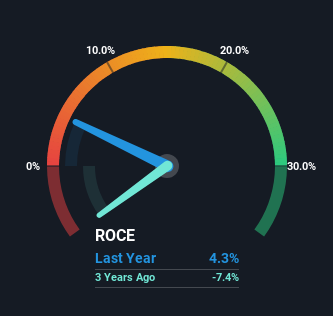We Like These Underlying Return On Capital Trends At Shanghai Dragon (SHSE:600630)

What trends should we look for it we want to identify stocks that can multiply in value over the long term? Firstly, we'd want to identify a growing return on capital employed (ROCE) and then alongside that, an ever-increasing base of capital employed. If you see this, it typically means it's a company with a great business model and plenty of profitable reinvestment opportunities. Speaking of which, we noticed some great changes in Shanghai Dragon's (SHSE:600630) returns on capital, so let's have a look.
Return On Capital Employed (ROCE): What Is It?
For those who don't know, ROCE is a measure of a company's yearly pre-tax profit (its return), relative to the capital employed in the business. The formula for this calculation on Shanghai Dragon is:
Return on Capital Employed = Earnings Before Interest and Tax (EBIT) ÷ (Total Assets - Current Liabilities)
0.043 = CN¥37m ÷ (CN¥1.7b - CN¥785m) (Based on the trailing twelve months to September 2024).
So, Shanghai Dragon has an ROCE of 4.3%. Ultimately, that's a low return and it under-performs the Luxury industry average of 6.5%.
Check out our latest analysis for Shanghai Dragon

Historical performance is a great place to start when researching a stock so above you can see the gauge for Shanghai Dragon's ROCE against it's prior returns. If you're interested in investigating Shanghai Dragon's past further, check out this free graph covering Shanghai Dragon's past earnings, revenue and cash flow.
What Does the ROCE Trend For Shanghai Dragon Tell Us?
While the ROCE is still rather low for Shanghai Dragon, we're glad to see it heading in the right direction. The figures show that over the last five years, returns on capital have grown by 61%. The company is now earning CN¥0.04 per dollar of capital employed. In regards to capital employed, Shanghai Dragon appears to been achieving more with less, since the business is using 53% less capital to run its operation. A business that's shrinking its asset base like this isn't usually typical of a soon to be multi-bagger company.
On a separate but related note, it's important to know that Shanghai Dragon has a current liabilities to total assets ratio of 47%, which we'd consider pretty high. This can bring about some risks because the company is basically operating with a rather large reliance on its suppliers or other sorts of short-term creditors. While it's not necessarily a bad thing, it can be beneficial if this ratio is lower.
What We Can Learn From Shanghai Dragon's ROCE
From what we've seen above, Shanghai Dragon has managed to increase it's returns on capital all the while reducing it's capital base. And investors seem to expect more of this going forward, since the stock has rewarded shareholders with a 65% return over the last five years. So given the stock has proven it has promising trends, it's worth researching the company further to see if these trends are likely to persist.
If you'd like to know about the risks facing Shanghai Dragon, we've discovered 1 warning sign that you should be aware of.
While Shanghai Dragon isn't earning the highest return, check out this free list of companies that are earning high returns on equity with solid balance sheets.
If you're looking to trade Shanghai Dragon, open an account with the lowest-cost platform trusted by professionals, Interactive Brokers.
With clients in over 200 countries and territories, and access to 160 markets, IBKR lets you trade stocks, options, futures, forex, bonds and funds from a single integrated account.
Enjoy no hidden fees, no account minimums, and FX conversion rates as low as 0.03%, far better than what most brokers offer.
Sponsored ContentNew: Manage All Your Stock Portfolios in One Place
We've created the ultimate portfolio companion for stock investors, and it's free.
• Connect an unlimited number of Portfolios and see your total in one currency
• Be alerted to new Warning Signs or Risks via email or mobile
• Track the Fair Value of your stocks
Have feedback on this article? Concerned about the content? Get in touch with us directly. Alternatively, email editorial-team (at) simplywallst.com.
This article by Simply Wall St is general in nature. We provide commentary based on historical data and analyst forecasts only using an unbiased methodology and our articles are not intended to be financial advice. It does not constitute a recommendation to buy or sell any stock, and does not take account of your objectives, or your financial situation. We aim to bring you long-term focused analysis driven by fundamental data. Note that our analysis may not factor in the latest price-sensitive company announcements or qualitative material. Simply Wall St has no position in any stocks mentioned.
About SHSE:600630
Flawless balance sheet with proven track record.
Market Insights
Community Narratives



